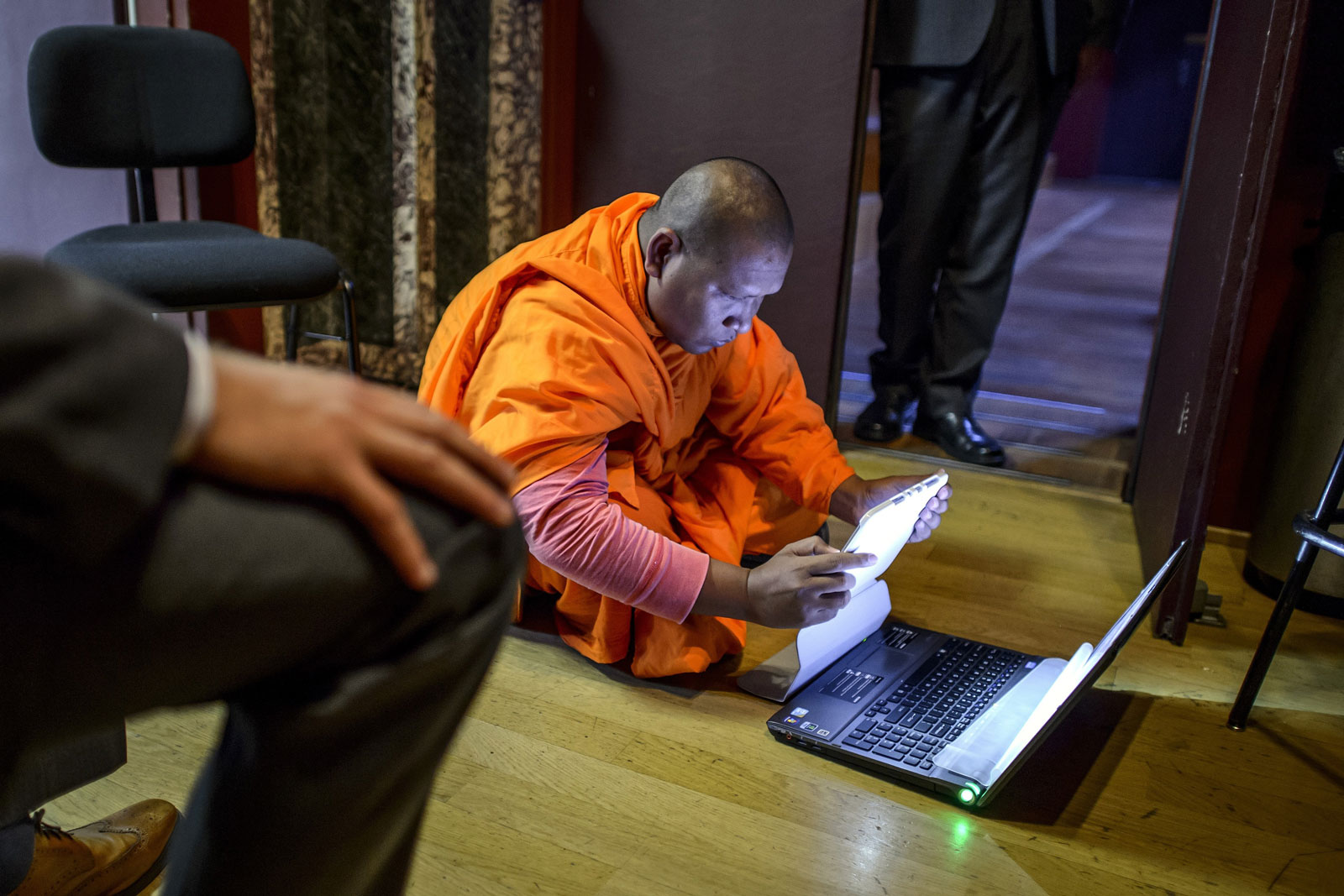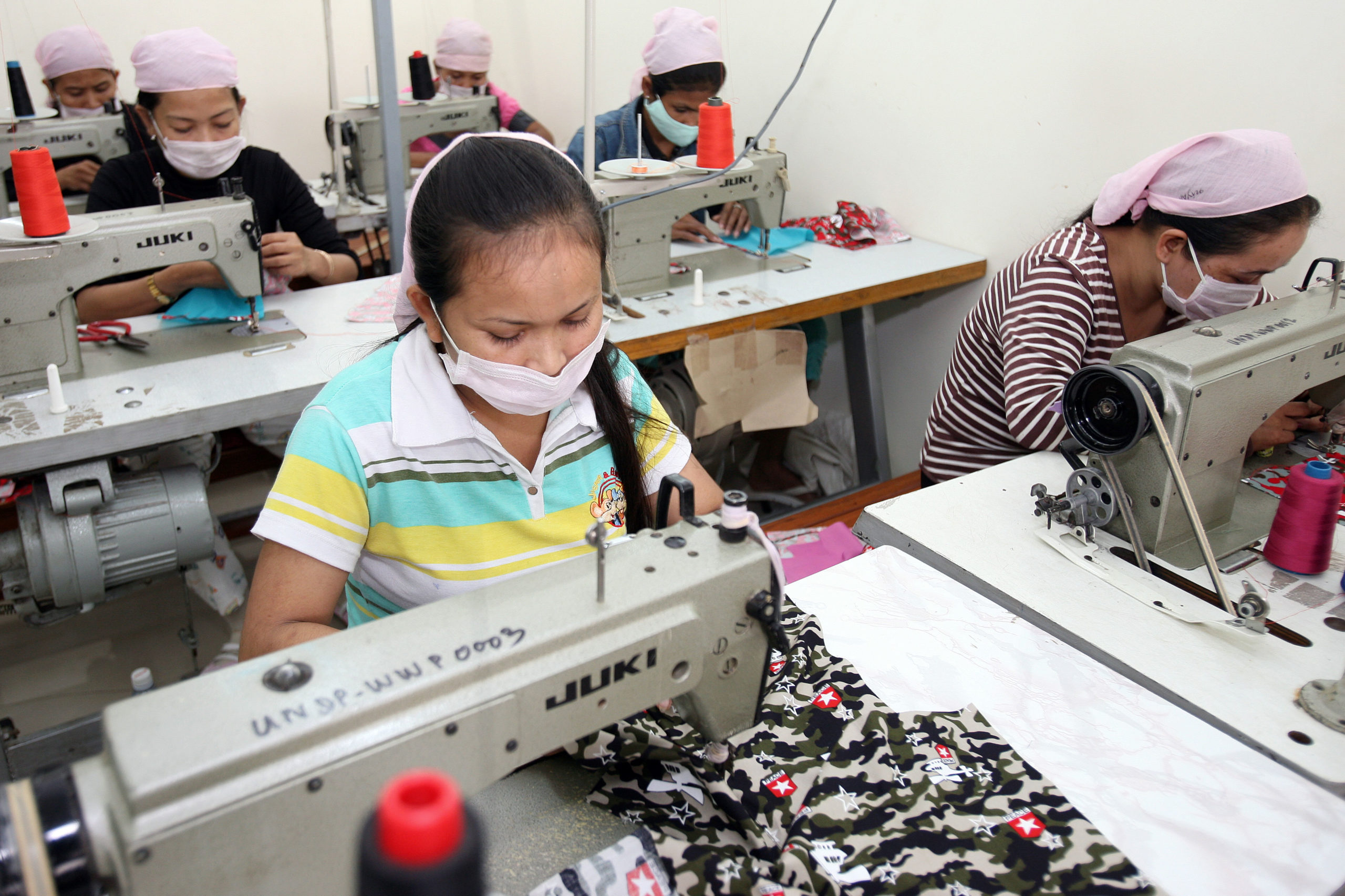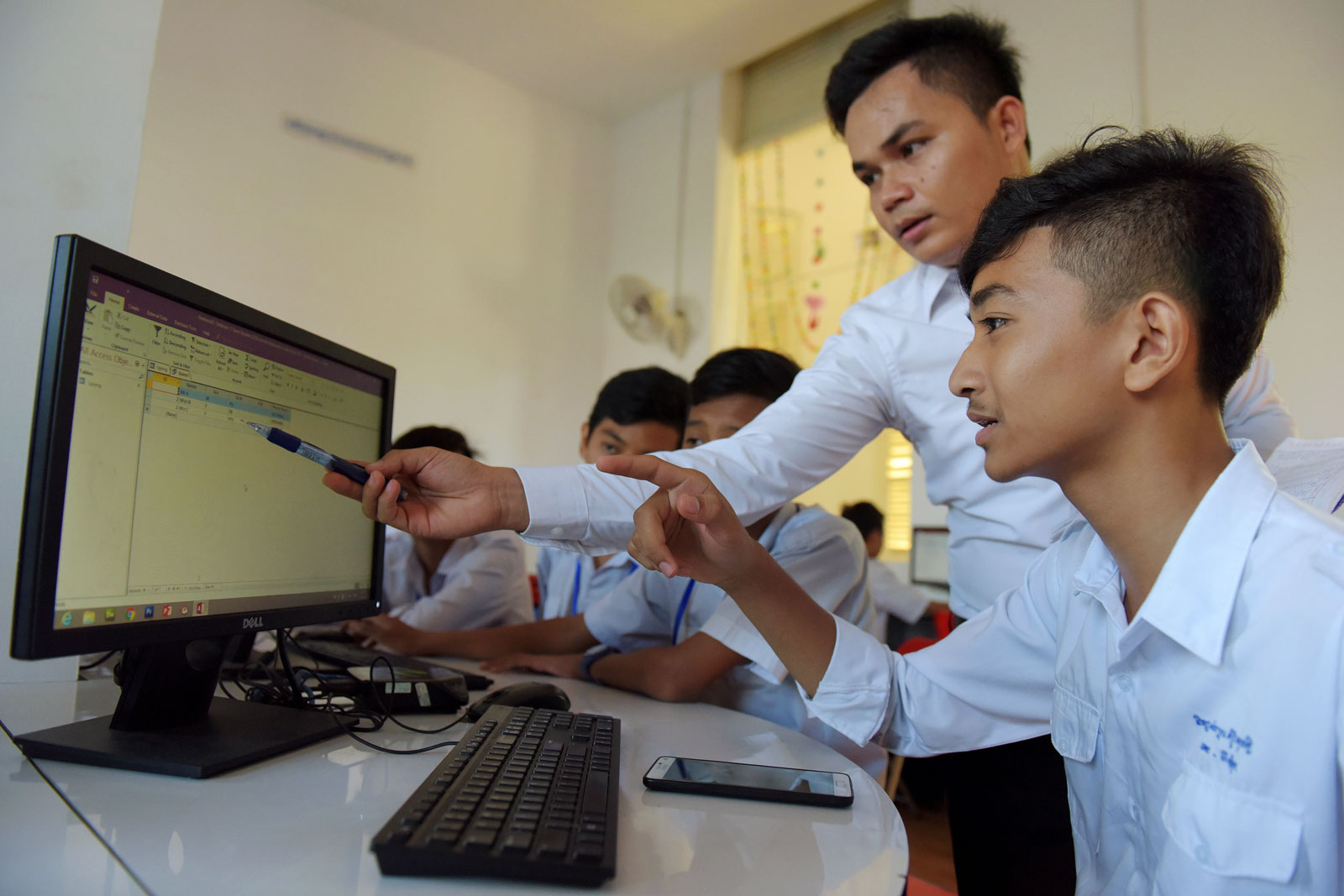Illustration by Séra
Better, faster, stronger – together.
That was the basic translation of the JapanCorp company slogan, and while Chantrea thought it was a bit cheesy, she had to admit it seemed accurate enough.
Chantrea had been an industrial engineer for more than a decade now, managing the systems that kept Cambodia’s manufacturing floors humming even after most of the human workers had left for the night. The Japanese firm that now employed her had opened this facility in 2038 in one of the special economic zones on the fringes of Phnom Penh. Now, just two years later, the firm was outperforming all competitors through its network of smart factories and distributors.
Some argued that JapanCorp home appliances were just that much better than other brands. Chantrea thought there was sense in that – and she did love a high-quality, made-in-Cambodia dishwasher as much as anyone else – but she chalked up the company’s growing success to its flexibility and speed of adaptation.
So it goes in Cambodia in 2040, a world remade by the revolutionising effect of the fourth industrial revolution (Industry 4.0).
Chantrea’s career is one built in a time when humans and artificial intelligence systems have long worked side-by-side to get big jobs done faster than ever before. This new industrial revolution is one characterised by free-flowing data, tighter connectivity between people, places and things and an increased pressure on workers to continuously upgrade their skills to keep up with the pace of change.
It’s a big subject, and in a developing country like Cambodia with a manufacturing-heavy economy, it’s one of special importance.
Tech rejuvenation
Back in 2019, Leewood Phu is a long-time consultant and tech adviser for the Cambodian government. He’s spent most of that time advocating for a more digitally literate society, something he sees as non-negotiable for success in a future that lives increasingly online.
“If we adopt tech, then we’ll be able to move forward faster,” he said. “But if we don’t adopt the latest technology, we will be left behind the bandwagon – the entire country. And if we’re left behind, we’ll see the economic gap widen and social instability grow as a result of that.”
Leewood is a contributor to the Cambodia 2040 project, an upcoming collection of essays to be published by Phnom Penh-based think-tank Future Forum. In his chapter for the coming book, he hits that theme with urgency, stressing that continuous tech rejuvenation is a necessity for staying afloat in a modern global economy.

That’s hardly a niche view today. Leading economists have raised that message with varying levels of alarm, particularly in the displacement of human workers by automated systems globally. And though some industries are more prone to automation than others, it’s likely that all of tomorrow’s workers will share space with robotic counterparts.
Global consultancy firm McKinsey reported in 2017 that approximately 50% of work activities today are “technically automatable”, predicting that roughly 400 million workers – in terms of full-time employment hours – could be made redundant by 2030.
It’s easy to look at such figures with alarm, especially in countries such as Cambodia where low-skilled manufacturing, an area ripe for automation, rules supreme.
But a tech-heavy economy is more complex than just the handover of work to robot replacements. After all, mechanised automation is a centuries-old practice, with increasingly sophisticated tech creating a wealth of innovations that have improved overall quality of life.
“People have focused very heavily on [the negative aspects of] automation, and that’s not the full impact,” said Jim Bessen, the executive director of the Technology and Policy Research Initiative at Boston University in the US. “It seems to be the most dramatic thing, but for a lot of reasons it’s not.”
This focus on the negative aspects of automation is based on the assumption that if a machine can do tasks that a human does, it will lead to less work for people. Pointing to historical examples, Bessen says that’s not always the case.
In the US textile industry, he explains, producers began investing heavily in automation during the 19th century, handing over an increasing number of work hours to machines. However, in that same period, human employment also increased throughout the industry.
“There was a large pent-up demand,” he said. “So when automation comes around and reduces the amount of labour [needed] to make one yard of cloth – in a competitive market, the price dropped. There was all this pent-up demand, so people wanted a lot more cloth. The amount they demanded grew a lot faster, so much so that even though it was less labour per yard, the amount of labour went up.”
But since the 1940s, Bessen said, that trend has reversed. Now, while a largely automated US industrial sector is still producing huge quantities of textiles, there are far fewer humans involved in the process.

By the time the mid-20th century rolled around, factories that employed humans and machines side-by-side produced supply that gradually outstripped demand. Human workers started looking a lot more expensive – and, in the West, this is where the jobs were eventually lost in the 70s and 80s, partly to automation, and partly to cheap labour in countries like Cambodia.
Regional integration
Much of that earlier story of automation in the West played out in a world where globalisation wasn’t the significant factor it is today. But our modern, transnational economy adds extra layers to the picture.
Economics researcher Sok Kha sees one avenue for safe growth for Cambodia in greater regional economic integration. Kha, a contributor to Future Forum, penned a chapter for Cambodia 2040 looking to the decades to come as a time of greater connectivity across Southeast Asia. Though he looks to the ASEAN bloc for greater integration, he also studied at length the connection between Cambodia and other Asian powerhouses like Japan, China and India.
Today, Cambodian-produced garments make up roughly 77% of the country’s total exports, and Kha notes that 80% of this sum is sold to just eight countries, including the US and destinations in the EU.
Cambodia’s repressive domestic politics and steady embrace of one-party rule have led to an increasingly shaky relationship with the West, economies that fuelled much of its manufacturing growth. Though China has been a reliable investor in the Kingdom’s economy in recent years, particularly in real estate and construction, Kha and others see a danger in relying too much on any one trading partner.
“Despite its membership in [ASEAN], Cambodia has not yet fully reaped the benefits of this regional integration,” Kha wrote in the 2040 project, underlining the Kingdom’s meagre intra-ASEAN trade. “Only around one-fifth of Cambodia’s exports are sold to ASEAN member states.”
While low, it’s in line with other ASEAN nations. Members have succeeded in better integrating economic activity, largely by reducing or eliminating tariffs and other trade barriers, but intra-ASEAN trade remained at only about 23% of the bloc’s total as of 2017.
Kha sees a future for Cambodia that places the Kingdom more centrally in ASEAN by taking advantage of its location in the Mekong subregion as a potential hub for transportation and logistics. Both of those will require bigger infrastructural investments, both in enhanced human capital and the brick-and-mortar development of better roads, railways and shipping ports.
On the latter point, he cites the economic partnership with China, which has engaged in its own global diplomacy campaign with the Belt and Road Initiative (BRI), as having the potential to pay big dividends for a modernising Cambodia. But the reality of this is complex.
Besides cautionary tales of other countries who have found themselves indebted to China through BRI developments, there are also political costs to too-openly favouring one partner over others.

Kha acknowledges that an “overdependence” on China will “increasingly constrain Cambodia’s policy options in regard to both international relations and economic development, giving rise to the risk of damage to the spirit of unity, cohesiveness, and centrality of ASEAN”.
He’s not the first to suggest this. Murray Hiebert spent three decades working in Southeast Asia and is now the senior associate of the Southeast Asia Program at the Center for Strategic and International Studies.
Hiebert told Southeast Asia Globe that Cambodia has an untapped regional advantage in terms of producing rice, fruit and vegetables. However, he asserts the Kingdom is “most famous for doing China’s bidding by blocking consensus within ASEAN on the South China Sea”.
Cambodia is already irritating other ASEANs by blocking the grouping from coming up with even inane statements about Chinese assertiveness in the South China Sea
Murray Hiebert, senior associate of the Southeast Asia Program at the Center for Strategic and International Studies
Growing Chinese influence and the resulting geopolitical issues could serve as an obstacle not just to Cambodia but to the bloc as a whole. To protect the cohesion of ASEAN, Hiebert says, member-states will need to start better supporting each other against Beijing on South China Sea disputes or transnational environmental concerns, such as hydropower developments on the Mekong.
“Cambodia is already irritating other ASEANs by blocking the grouping from coming up with even inane statements about Chinese assertiveness in the South China Sea,” Hiebert wrote. “Cambodia will likely alienate its ASEAN neighbours further if it goes ahead and allows the Chinese Navy to use its Ream naval port along the Gulf of Thailand.”
Creating smart cities
But while historically businesses would have been beholden to discussions at an inter-governmental level to facilitate this greater integration, today, in our digitalised economy, individuals and services can bypass such restrictions through the internet – especially in urban centres like Phnom Penh.
That’s one idea put forth in a “smart city” concept by economics researchers Sithy Rath Daravuth and Vrak Thanit in their Future Forum chapter. It rests on a mix of national policy and local urban development, all of which would theoretically come together to reform Phnom Penh in the decades to come into a smart centre crossing borders on 5G or 6G networks.
This economy would be rooted in booming e-commerce, the multi-trillion-dollar online marketplace for goods and services, and a multitude of tech industries only now emerging. Those could include 3D printing, blockchain and the “Internet of Things” – the wide-reaching process of connecting physical objects to a network of digital information.
To fully capitalise on this new economy, the chapter’s authors write, Cambodia would first need to build the right “urban digital environment”. They define that as a joint public and private sector effort to build cohesive infrastructure both in the physical world, such as with adequate supply of electricity and connectivity, and in terms of policy and cybersecurity.
“Many, if not all, of these conditions are still either absent or sub-standard [in Cambodia] in the present interlude,” the authors note.

Besides creating an innovation-friendly space, the Kingdom would also need to upskill its workforce to take full advantage of a rapidly changing global economy. That could happen through a deeper emphasis on STEM development in public schools and skills training for workers through public-private partnerships.
Researchers also found that firms that invested in automation also typically increased job creation, a finding Bessen suggested could apply on the national level. Similarly, tech innovation in the decades to come will create opportunities few can imagine today. The internet, an unfathomable dream for most a mere 30 years ago, is now a job creator on an immeasurable scale, creating whole industries that didn’t exist in the 1990s.
However they achieve it, the workers of 2040 will need to be nimble if they’re to stay in the game – no matter if they’re seeking jobs in Cambodia or Canada – as the displacing effect of automation will force many workers into periods of transition from one role to the next.
Bessen said these periods are a “distinct burden” that underlie the more optimistic figures about net job security in the future.
While social policy that takes technological advancement and automation into account is still in its infancy, Bessen said governments should help ease transitions by providing resources for displaced workers to learn new skills. This could be vital in Cambodia, where automation in manufacturing will one day phase out many low-skill positions.
The downside comes in the potential for economic disparity that builds when the balance of power is tilted away from labour and toward the owners of AI-powered systems.
But Bessen’s message for ensuring the welfare of workers in the future is a simple one.
“The more widely you can spread [education and training programmes], the more equality you’ll have.”
This article has been researched and written in partnership with Future Forum, in the lead up to Future Forum’s upcoming Cambodia 2040 book launch. Find out more here.



